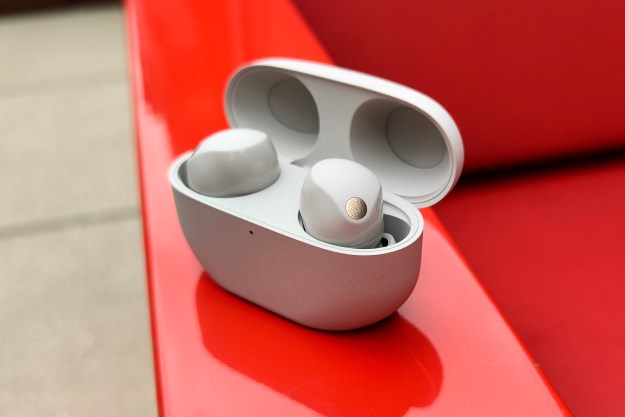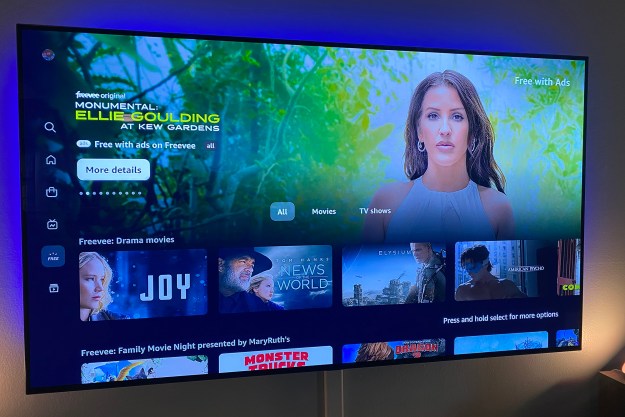“The Encore has more than a few whiz-bang features, but power users will be disappointed...”
- Ultra-low power consumption; extremely easy to use; dual audio zones; attractive form factor; supports FLAC
- Oversimplified in many respects; no HDMI port; no HDCP support; network interface limited to 100Mb/sec
Summary
Personal computers are complex, beastly machines compared to plug-and-play devices like a DVD player or a TiVo. Cirgon’s Encore Digital Media Server is the latest attempt to tame the animal and reduce it to an acquiescent consumer electronics product. The Encore has more than a few whiz-bang features, but power users will be disappointed by several design compromises.
Unlike most PCs that would like to take up residence in your living room—Dell’s XPS One or HP’s TouchSmart, for instance—this one doesn’t rely on any form of Microsoft’s Windows operating system. Cirgon instead designed an entirely custom graphical user interface and laid it on top of the Linux operating system. And by avoiding the excess baggage that comes with Windows, Cirgon was able to build a PC using simpler components that consume considerably less power.
Lower power consumption means less heat production, which in turn reduces the need for noisy fans. HP’s TouchSmart IQ506 PC is a fairly quiet, low-power computer, yet when we plugged it into a Kill-a-Watt power meter the TouchSmart registered electrical consumption of 85 watts when idle and 95 watts while ripping a CD (a task that taps the CPU, the hard drive, and the optical drive). Compare that to the Encore, which consumed just 30 watts while idle and about 48 watts while ripping a CD.
Slick Feature Set
Despite its low-power footprint, the Encore boasts some features that we’ve never seen on a regular PC. But it would be a big mistake to buy this machine instead of a PC. When you plug in a digital camera, for instance, the machine will automatically offload the pictures and then ask if you’d like to create a back-up DVD with all the same photos. Brilliant! But once those photos are on the server, you’ll discover that all you can do is crop them and organize them into albums. There’s no photo editor and no way to add one.
On the plus side, you can plug in a USB microphone and add narration to any photo, and you can easily create slideshows—with our without music—and burn them to DVD. Even cooler, the music’s volume level will automatically fade back when a narrated slide appears. The Photo Resize directory is also extremely cool. Any photos copied to this folder are automatically reduced to a predetermined size (ranging from 640×480 to 1280×1024) in order to render them more manageable for attaching to email or for uploading to an online photo site such as Flickr. But since this isn’t a typical PC, you can’t use it to actually send those emails or upload those photos to Flickr. It won’t help you balance your checkbook, write the next great American novel, play games, or do a hundred other things that conventional PCs are useful for, either.

Encore Digital Media Server
Curious Limitations
You can listen to Internet radio stations, but of the hundreds operating today, Cirgon oddly limits you to three: Last.FM, Sirius and XM Radio. The Encore will rip CDs and automatically download album art, song titles, and artist names for you, but it provides only two encoding choices: Uncompressed WAV (perfect fidelity, but with intense storage consumption), or MP3 at a bit rate of 320Kb/sec. (Note: The machine we evaluated ripped MP3s at a bit rate of 128Kb/sec, but when we fact-checked this story with Cirgon, a company representative told us our unit was misconfigured at the factory and that production servers rip at the higher bit rate.)
Fortunately, the Encore will play tracks encoded with FLAC (a lossless codec that delivers bit-perfect fidelity in files much smaller than WAV files). Our advice to Encore buyers would be to rip CDs using another PC and transfer them to the Encore over the network. (Cirgon’s rep also told us that they’ve now decided to enable the server to rip to FLAC as an option.) The machine also supports audio files in OGG and AAC format, but it cannot run iTunes and you can’t use it to purchase music from the iTunes store or any other online retailer.
The Encore won’t rip DVDs (not surprising, since that would run afoul of the consumer-hostile Digital Millennium Copyright Act), but it will play movies you’ve ripped using another PC. And since it doesn’t have a TV tuner it can’t function as a DVR.

Encore Digital Media Server
Bones to Pick
We have bigger complaints about some of Cirgon’s other design decisions, though. For starters, the machine’s digital video output is limited to DVI. Had the manufacturer used a motherboard that supported HDMI, you’d be able to connect the box to your TV or properly equipped A/V receiver with a single cable that carried both digital video and digital audio. Even more troublesome is the fact that the Encore doesn’t support HDCP, either, and Cirgon admits that some newer TVs will not accept a digital signal in which HDCP is not present.
The company suggests that people who own TVs that don’t support digital video without HDCP fall back to the Encore’s analog component-video output, but that strikes us an entirely unsatisfactory compromise. TV manufacturers have been taking a laidback approach to HDCP enforcement, but that’s going to change over time. Incidentally, the absence of HDCP support also explains why the Encore isn’t available with a Blu-ray drive, even as an option. What you do get is a DVD burner.
The Encore’s audio connections are much more robust. In addition to stereo analog output and eight-channel digital audio outputs (optical and coaxial), the Encore is equipped with a Zone 2 audio channel that can play music independently of what’s happening on Zone 1’s channel (provided you have an amp or self-powered for that second zone, or an A/V receiver that can handle two zones). What’s more, you can play music on the Zone 1 channel in the background. This means that song titles and album art are not displayed while the music is playing, so you can run a photo slideshow at the same time.
The Encore has a built-in Ethernet network interface card (NIC), but it’s limited to speeds of up to 100 megabits per second. Most conventional PCs in this price range are equipped with one or even two NICs capable of running at speeds up to one gigabit per second. The speed difference is meaningless when it comes to streaming audio or video across a network, but it will take much longer to transfer large numbers of files over the network.

Encore Digital Media Server
Conclusion
The company sent us a pre-programmed iconRemote universal remote control, which we really liked, but since we didn’t have the opportunity to compare it to the standard model, we can’t say if the upgrade is worth $125. The system doesn’t require a keyboard, but it will host a USB model—a solution we much preferred to using the on-screen keyboard the few times we needed to input text.
Cirgon is on to something here. The Encore is exceedingly easy to use, consumes very little power, and delivers excellent picture quality. We dig its dual audio zones, too. The absence of an HDMI port and a gigabit network interface are bummers, but the lack of HDCP support is a genuine buzzkill.
Pros:
- Ultra-low power consumption
- Extremely easy to use
- Dual audio zones
- Attractive form factor
- Supports FLAC
Cons:
- Oversimplified in many respects
- No HDMI port
- No HDCP support
- Network interface limited to 100Mb/sec
Editors' Recommendations
- Ifi says its latest portable DAC restores the missing quality in digital audio
- How to convert your VHS tapes to DVD, Blu-ray, or digital
- HDMI ARC or digital optical: what’s the difference, and which is best for you?
- What is MQA? The controversial digital audio format fully explained
- Tivoli Audio’s Model Two Digital speaker abandons terrestrial radio


